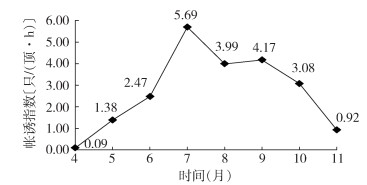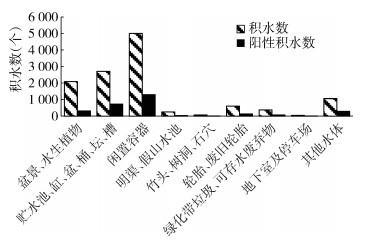扩展功能
文章信息
- 曹阳, 韦凌娅, 邵汉文, 王慧敏, 孔庆鑫
- CAO Yang, WEI Ling-ya, SHAO Han-wen, WANG Hui-min, KONG Qing-xin
- 2019年杭州市蚊虫监测及生态学特征
- osquito surveillance and bionomics in Hangzhou, Zhejiang province, China, 2019
- 中国媒介生物学及控制杂志, 2021, 32(6): 691-695
- Chin J Vector Biol & Control, 2021, 32(6): 691-695
- 10.11853/j.issn.1003.8280.2021.06.007
-
文章历史
- 收稿日期: 2021-03-09
蚊虫不仅骚扰吸血,还是登革热、疟疾等疾病的传播媒介[1-2]。媒介生物监测和防制是相关传染病防控的基础性工作[3],科学有效的媒介蚊虫监测能够评估蚊媒传染病暴发风险,及时作出预警,以采取最佳的蚊媒控制措施[4-5]。通过对蚊虫的生态学监测,可以了解蚊虫种类、密度、分布、种群构成、季节消长等信息[6],为蚊媒传染病防制提供参考依据。为掌握杭州市2019年蚊虫密度及季节变化趋势,有效预防和控制蚊媒传染病的发生和流行,本文对杭州市2019年蚊虫密度监测结果进行了分析。
1 材料与方法 1.1 数据来源来自杭州市2019年15个区(县、市)媒介蚊虫监测报表,监测按照《浙江省病媒生物监测方案》相关要求开展。
1.2 监测点按照《全国病媒生物监测实施方案》和《浙江省病媒生物监测方案》的要求,分别设立国家级、省级和常规监测点。将上城、下城、拱墅、江干和西湖区作为国家级监测点,余杭区和建德市作为省级监测点,其他区作为常规监测点。
1.3 监测频次成蚊监测时间为4-11月,幼蚊为3-11月。成蚊监测采用诱蚊灯法和双层叠帐法,诱蚊灯法国家和省级监测点2次/月,常规监测点1次/月。双层叠帐法国家级监测点2次/月,其他监测点1次/月;幼蚊监测采用布雷图指数(BI)法,省级监测点2次/月,其他监测点1次/月。
1.4 监测方法 1.4.1 诱蚊灯法城区选择城镇居民区、公园、医院各不少于2处,农村选择民房和牲畜棚各不少于2处。选择远离干扰光源和避风的场所作为挂灯点,每处监测生境放置诱蚊灯1台。诱蚊灯光源离地1.5 m,日落前1 h接通电源,直至次日日出后1 h。将捕获的蚊虫鉴定种类、性别并计数。
1.4.2 双层叠帐法选择居民区、公园/竹林、旧轮胎堆放地/废品站/工地等3类生境各不少于1处,每处做2个帐次。选择避风遮阴处放置蚊帐,诱集者位于内部封闭蚊帐中暴露两条小腿,收集者用电动吸蚊器在两层蚊帐之间收集停落的伊蚊,持续30 min,捕获的蚊虫分类鉴定。
1.4.3 BI法每个监测点按不同地理方位选择4个街道/村的居民区等调查≥200户。检查记录室内外所有小型积水容器及其幼蚊孳生情况,收集阳性容器中的幼蚊进行种类鉴定。
1.5 密度指标计算

|
应用Excel 2019软件进行数据整理,计算蚊密度、帐诱指数及BI,并做统计图、表进行描述性分析。
2 结果 2.1 诱蚊灯法监测结果蚊密度平均为3.09只/(灯·夜)(表 1),蚊虫密度季节消长呈单峰型,7月最高,为7.42只/(灯·夜),之后迅速下降,蚊虫活动高峰出现在6-8月(图 1)。淡色(致倦)库蚊(Culex pipiens pallens/quinquefasciatus)为主要蚊种,占76.88%,其次为骚扰阿蚊(Armigeres subalbatus)、白纹伊蚊(Aedes albopictus)、三带喙库蚊(Cx. tritaeniorhynchus)和中华按蚊(Anopheles sinensis),分别占总捕获数的14.16%、4.33%、2.65%和1.98%。不同生境中,牲畜棚/养殖场蚊密度最高,为7.88只/(灯·夜),其次为城镇居民区,医院最低,为1.72只/(灯·夜),捕获的主要蚊种均为淡色(致倦)库蚊。

|

|
| 图 1 2019年杭州市蚊密度季节消长趋势 Figure 1 Seasonal fluctuations in mosquito density in Hangzhou, 2019 |
| |
帐诱指数平均为2.70只/(顶·h)(表 2),7月最高,为5.69只/(顶·h),白纹伊蚊活动高峰集中在6-10月(图 2)。各区(县、市)中桐庐县帐诱指数最低,为0。捕获蚊虫均为白纹伊蚊,未监测到埃及伊蚊。不同生境类型帐诱指数分布差异较大,废旧物品处/工地最高,为4.32只/(顶·h)。

|

|
| 图 2 2019年杭州市白纹伊蚊密度季节消长趋势 Figure 2 Seasonal fluctuations in Aedes albopictus density in Hangzhou, 2019 |
| |
平均BI值为8.84(表 3),BI值季节变化呈单峰模式,高峰出现在7月,为16.86,8月以后快速下降,其中6-8月均BI > 10.00(图 3)。积水和阳性积水类型主要为贮水池、缸、盆、桶、坛、槽,闲置容器,盆景、水生植物,阳性率分别为26.80%(728/2 716)、26.03%(1 304/5 009)和14.69%(307/2 090),其中闲置容器阳性数量最多,为1 304个。见图 4。

|

|
| 图 3 2019年杭州市白纹伊蚊幼蚊密度季节消长趋势 Figure 3 Seasonal fluctuations in density of Aedes albopictus larvae in Hangzhou, 2019 |
| |

|
| 图 4 杭州市不同积水类型、数量及幼蚊阳性积水数量 Figure 4 The number of different types of water and of mosquito larvae positive water in Hangzhou |
| |
2019年杭州市蚊密度、帐诱指数及BI均在7月达到最高值,之后呈下降趋势。由于陆续出现登革热输入病例及散发的本地病例,杭州市在7月大规模开展环境整治和化学杀虫工作,也表明杭州市蚊虫密度季节消长与其气候特点密切相关,7月多云及阴雨天气达29 d,最低和最高平均气温分别为24.8 ℃和31.7 ℃,非常适宜蚊虫生长繁殖,可能是导致蚊虫密度高的重要原因。
诱蚊灯监测结果显示,捕获的主要蚊种为淡色(致倦)库蚊,占76.88%,可能与蚊虫的栖息及吸血习性密切相关。淡色(致倦)库蚊通常在日落后1 h与黎明时为吸血活动高峰[7],诱蚊灯监测时间为日落前1 h至日出前1 h,与其活动高峰时段相吻合。不同监测生境中牲畜棚/养殖场的蚊密度最高,有研究指出蚊虫的活动区域和范围与对宿主的选择密切相关,不同生境蚊密度有所差异,可能与血源稳定性与适口性有关[8-9]。淡色(致倦)库蚊喜吸畜血,牲畜棚/养殖场多为户外露天场所且无有效防蚊灭蚊设施,故而成为淡色(致倦)库蚊密度最高的场所。
从诱蚊灯捕获的蚊种构成来看,白纹伊蚊仅占捕获蚊虫总量的4.33%,这与诱蚊灯诱集库蚊和按蚊的效率较高有关。诱蚊灯通常对夜间活动的蚊虫引诱效果较好,如中华按蚊、淡色库蚊等,而白纹伊蚊主要在白天活动,因此对白纹伊蚊的引诱效果较差[10]。故本监测所使用的诱蚊灯更适宜用于反映淡色库蚊等夜间活动蚊虫的密度及侵害程度,白纹伊蚊的捕获率较低并不能代表其实际侵害状况。
2019年杭州市帐诱指数和BI在6-10月均维持在较高水平,其中BI在6-8月均超过10.00,提示有登革热传播暴发风险,8-10月本市又出现登革热散发病例,也反映出白纹伊蚊的实际密度水平。作为登革热的重要传播媒介,其密度指标的变化对登革热传播流行风险的评估有重要指导意义。尤其在进行登革热媒介伊蚊应急监测时,快速准确地监测白纹伊蚊密度更为重要。因此,近年来出现了很多监测效率更高,受监测人员、场地、气象等主客观因素限制较小的白纹伊蚊成蚊监测方法,如CO2诱蚊灯法、BG-trap捕蚊器法等。高健荣等[11]指出CO2诱蚊灯对白纹伊蚊诱捕效果优于紫外光诱蚊器,可用于日昼活动蚊种如白纹伊蚊的监测。凌超等[12]发现CO2诱蚊灯捕获的白纹伊蚊比例明显高于普通诱蚊灯。李剑泉等[13]也发现CO2诱蚊灯可通过低浓度的CO2对蚊虫的引诱效应,提高对白纹伊蚊的捕获率。马德珍等[14]发现BG-trap捕蚊器捕获白纹伊蚊的效率远优于普通诱蚊灯,更适用于登革热媒介伊蚊监测。韦凌娅等[15]也指出BG-trap诱蚊器更加适合登革热疫情等蚊媒传染病的应急监测使用。综上所述,这些方法与常规监测方法结合使用可提升监测效率,特别是发生登革热疫情应急监测时。在实际工作中,根据监测目的不同,灵活选用适宜的、效率更高的方法,可以达到更准确的监测效果。
BI法监测结果显示,闲置容器仍然是最主要的幼蚊孳生地,提示仍需持续开展清除孳生地和杀灭成蚊的措施。应依据当年蚊密度季节变化趋势,结合本市气候特点,加强对当年气象因素如气温、降水量的监测,当发现气温升高、降水量增加,结合媒介蚊虫孳生特点,及时进行相关疾病的预警和评估,提前采取以清除孳生地为主的综合防制措施,必要时辅以杀虫剂灭蚊,控制媒介蚊虫密度,以达到从源头上控制媒介蚊虫密度,有效预防相关蚊媒疾病发生和传播的目的。
利益冲突 无
| [1] |
刘起勇. 新时代媒介生物传染病形势及防控对策[J]. 中国媒介生物学及控制杂志, 2019, 30(1): 1-6, 11. Liu QY. Epidemic profile of vector-borne diseases and vector control strategies in the new era[J]. Chin J Vector Biol Control, 2019, 30(1): 1-6, 11. DOI:10.11853/j.issn.1003.8280.2019.01.001 |
| [2] |
刘起勇. 气候变化对中国媒介生物传染病的影响及应对: 重大研究发现及未来研究建议[J]. 中国媒介生物学及控制杂志, 2021, 32(1): 1-11. Liu QY. Impact of climate change on vector-borne diseases and related response strategies in China: major research findings and recommendations for future research[J]. Chin J Vector Biol Control, 2021, 32(1): 1-11. DOI:10.11853/j.issn.1003.8280.2021.01.001 |
| [3] |
吴海霞, 刘小波, 刘起勇. 我国病媒生物防控现状及面临的问题[J]. 首都公共卫生, 2018, 12(1): 4-6. Wu HX, Liu XB, Liu QY. Current status and problem of vector prevention and control in China[J]. Capital J Public Health, 2018, 12(1): 4-6. DOI:10.16760/j.cnki.sdggws.2018.01.002 |
| [4] |
闫冬明, 黄坤, 赵春春, 等. 常用蚊虫监测方法和技术研究进展[J]. 中国媒介生物学及控制杂志, 2020, 31(1): 108-112. Yan DM, Huang K, Zhao CC, et al. Research advances in common methods and techniques for mosquito surveillance[J]. Chin J Vector Biol Control, 2020, 31(1): 108-112. DOI:10.11853/j.issn.1003.8280.2020.01.023 |
| [5] |
刘起勇, 孟凤霞, 樊景春. 中国重要病媒生物应急监测与控制[J]. 中国媒介生物学及控制杂志, 2011, 22(1): 1-4. Liu QY, Meng FX, Fan JC. Vector surveillance and control in emergencies in China: proceedings and perspectives[J]. Chin J Vector Biol Control, 2011, 22(1): 1-4. |
| [6] |
刘起勇. 病媒生物监测预警研究进展[J]. 疾病监测, 2018, 33(2): 123-128. Liu QY. Research progress on the vector surveillance and early-warning[J]. Dis Surveill, 2018, 33(2): 123-128. DOI:10.3784/j.issn.1003-9961.2018.02.005 |
| [7] |
叶真, 夏时畅. 病媒生物综合防制技术指南[M]. 杭州: 浙江大学出版社, 2012: 18. Ye Z, Xia SC. Guidelines for comprehensive prevention and control of vector organisms[M]. Hangzhou: Zhejiang University Press, 2012: 18. |
| [8] |
马勇建, 付磊磊, 张云兰, 等. 2017-2018年滨州市蚊蝇种群结构及季节消长分析[J]. 现代预防医学, 2019, 46(17): 3197-3200, 3210. Ma YJ, Fu LL, Zhang YL, et al. Population structure and seasonal fluctuation of mosquitoes and flies of Binzhou, 2017-2018[J]. Mod Prev Med, 2019, 46(17): 3197-3200, 3210. |
| [9] |
周甜宇, 顾敏华, 张建军, 等. 2008-2017年江阴市蚊虫监测分析[J]. 中华卫生杀虫药械, 2019, 25(5): 432-436. Zhou TY, Gu MH, Zhang JJ, et al. Surveillance of mosquitoes from 2008 to 2017 in Jiangyin city[J]. Chin J Hyg Insect Equip, 2019, 25(5): 432-436. DOI:10.19821/j.1671-2781.2019.05.011 |
| [10] |
Govella NJ, Chaki PP, Mpangile JM, et al. Monitoring mosquitoes in urban Dar es Salaam: evaluation of resting boxes, window exit traps, CDC light traps, Ifakara tent traps and human landing catches[J]. Parasit Vectors, 2011, 4(1): 40. DOI:10.1186/1756-3305-4-40 |
| [11] |
高健荣, 刘金华, 刘戟环, 等. CO2诱蚊器与紫外光诱蚊器效果对比[J]. 中华卫生杀虫药械, 2015, 21(4): 375-377. Gao JR, Liu JH, Liu JH, et al. The effect comparison between CO2 mosquito trapping device and Uv mosquito trapping device[J]. Chin J Hyg Insect Equip, 2015, 21(4): 375-377. DOI:10.19821/j.1671-2781.2015.04.016 |
| [12] |
凌超, 王韶华, 武峥嵘, 等. 两种成蚊监测法捕蚊效果的比较[J]. 医学动物防制, 2020, 36(3): 294-295. Ling C, Wang SH, Wu ZR, et al. Comparison of the effect of two adult mosquito monitoring methods in mosquito trapping[J]. J Med Pest Control, 2020, 36(3): 294-295. DOI:10.7629/yxdwfz202003026 |
| [13] |
李剑泉, 沈佐锐, 王丽英, 等. 白纹伊蚊对光线与二氧化碳的行为反应[J]. 昆虫知识, 2003, 40(4): 350-355. Li JQ, Shen ZR, Wang LY, et al. Behavioral response of the mosquito Aedes albopictus to light beams and carbon dioxide[J]. Entomol Knowledge, 2003, 40(4): 350-355. DOI:10.3969/j.issn.0452-8255.2003.04.015 |
| [14] |
马德珍, 明明, 陆华. 光催化诱蚊灯与BG-trap捕蚊器诱蚊效果比较研究[J]. 中国媒介生物学及控制杂志, 2020, 31(6): 685-689. Ma DZ, Ming M, Lu H. Mosquito-trapping effect of photocatalysis mosquito lamp versus BG-trap mosquito lamp[J]. Chin J Vector Biol Control, 2020, 31(6): 685-689. DOI:10.11853/j.issn.1003.8280.2020.06.012 |
| [15] |
韦凌娅, 孔庆鑫, 王慧敏. 双层叠帐法与BG-trap诱捕器法在登革热应急蚊媒监测中的捕蚊效果比较[J]. 中国媒介生物学及控制杂志, 2019, 30(1): 65-68. Wei LY, Kong QX, Wang HM. Effectiveness of double mosquito net and BG-trap for emergency vector surveillance during dengue fever epidemics: a comparative study[J]. Chin J Vector Biol Control, 2019, 30(1): 65-68. DOI:10.11853/j.issn.1003.8280.2019.01.014 |
 2021, Vol. 32
2021, Vol. 32


